System Design and Analysis: Comprehensive Homework Assignment Solution
VerifiedAdded on 2020/04/07
|14
|2290
|45
Homework Assignment
AI Summary
This document presents a comprehensive solution to a system design and analysis assignment. The assignment covers key concepts including system analysis methodologies, design activities, and the relationship between analysis and design phases. It delves into architectural patterns such as the three-tier client-server model and various hosting alternatives. Detailed explanations are provided for high-level and low-level design, along with fundamental design principles like coupling and cohesion. The solution also explores system modeling techniques using sequence and domain diagrams, and discusses design classes and methods. Further, it includes a section on user-centered design principles and human-computer interface aspects such as usability, clarity, and flexibility. The assignment also addresses database schema, distributed database architectures, and system control types, providing a well-rounded overview of system design and analysis principles and practices.
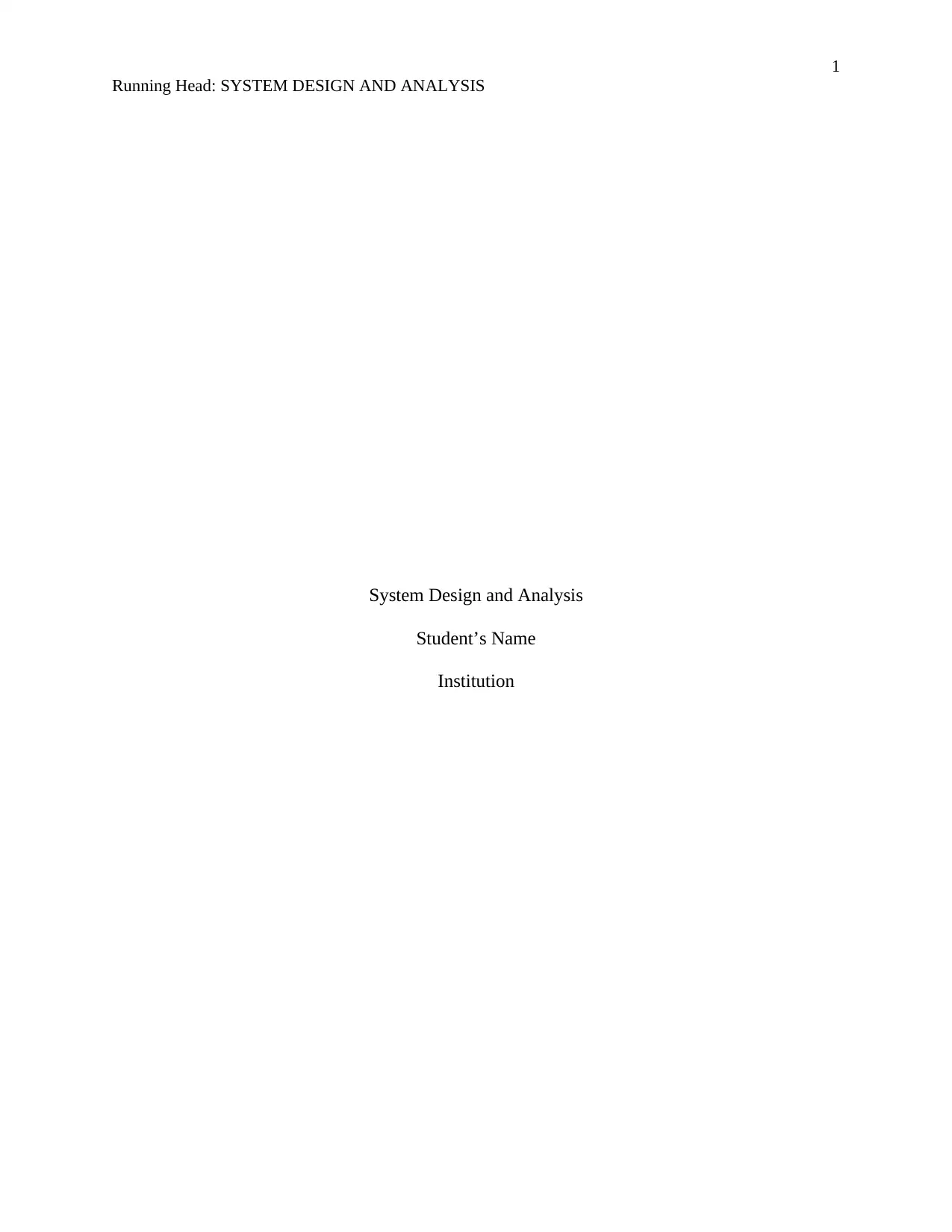
1
Running Head: SYSTEM DESIGN AND ANALYSIS
System Design and Analysis
Student’s Name
Institution
Running Head: SYSTEM DESIGN AND ANALYSIS
System Design and Analysis
Student’s Name
Institution
Paraphrase This Document
Need a fresh take? Get an instant paraphrase of this document with our AI Paraphraser
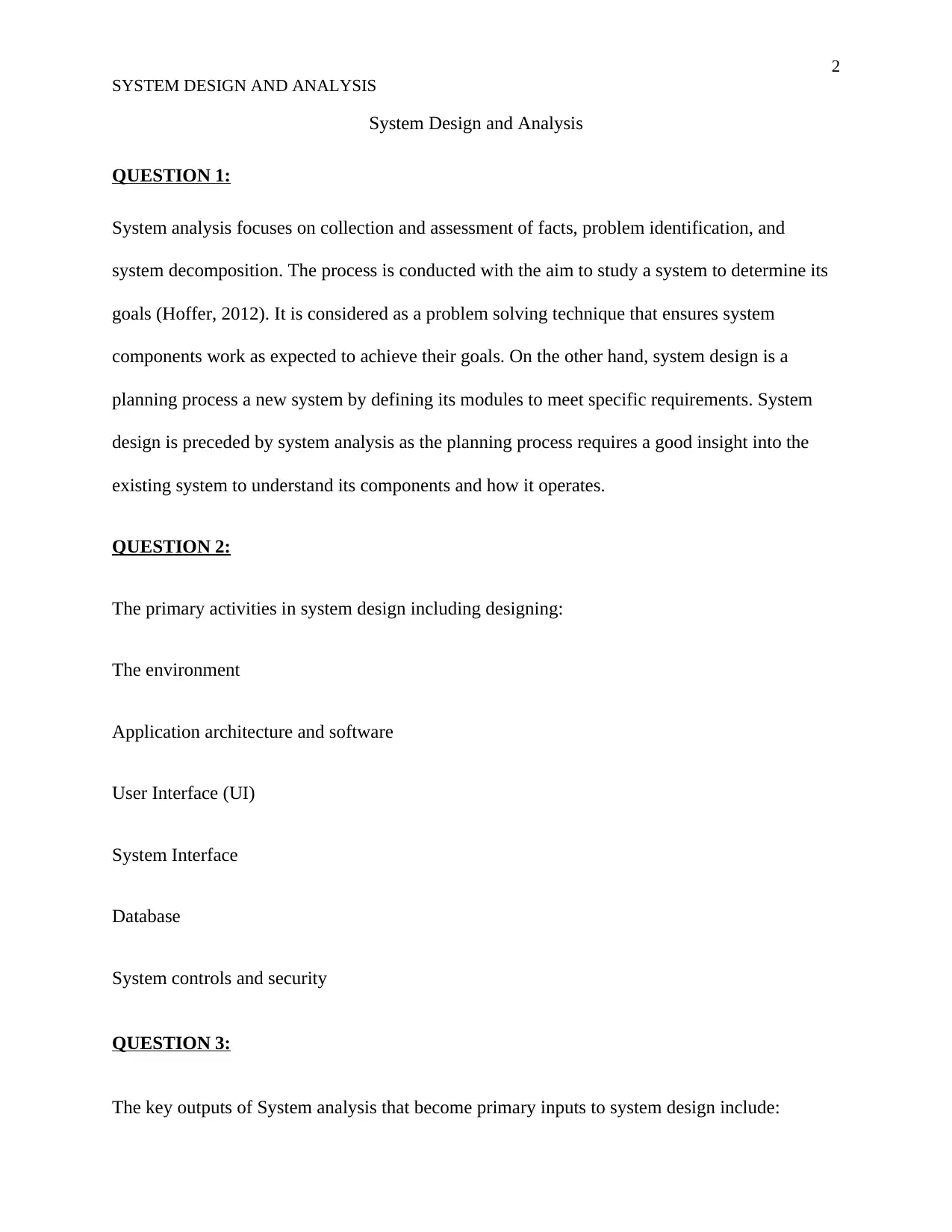
2
SYSTEM DESIGN AND ANALYSIS
System Design and Analysis
QUESTION 1:
System analysis focuses on collection and assessment of facts, problem identification, and
system decomposition. The process is conducted with the aim to study a system to determine its
goals (Hoffer, 2012). It is considered as a problem solving technique that ensures system
components work as expected to achieve their goals. On the other hand, system design is a
planning process a new system by defining its modules to meet specific requirements. System
design is preceded by system analysis as the planning process requires a good insight into the
existing system to understand its components and how it operates.
QUESTION 2:
The primary activities in system design including designing:
The environment
Application architecture and software
User Interface (UI)
System Interface
Database
System controls and security
QUESTION 3:
The key outputs of System analysis that become primary inputs to system design include:
SYSTEM DESIGN AND ANALYSIS
System Design and Analysis
QUESTION 1:
System analysis focuses on collection and assessment of facts, problem identification, and
system decomposition. The process is conducted with the aim to study a system to determine its
goals (Hoffer, 2012). It is considered as a problem solving technique that ensures system
components work as expected to achieve their goals. On the other hand, system design is a
planning process a new system by defining its modules to meet specific requirements. System
design is preceded by system analysis as the planning process requires a good insight into the
existing system to understand its components and how it operates.
QUESTION 2:
The primary activities in system design including designing:
The environment
Application architecture and software
User Interface (UI)
System Interface
Database
System controls and security
QUESTION 3:
The key outputs of System analysis that become primary inputs to system design include:
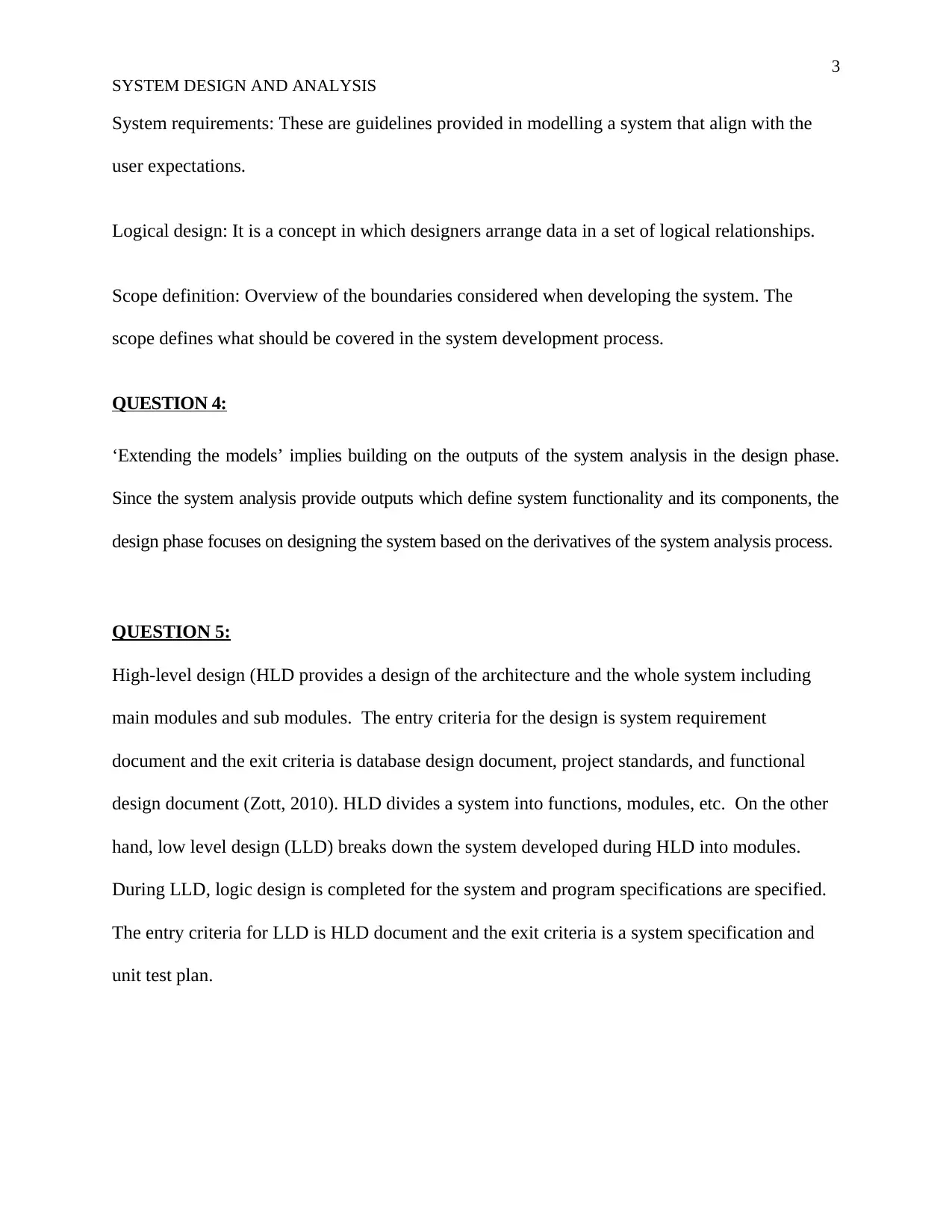
3
SYSTEM DESIGN AND ANALYSIS
System requirements: These are guidelines provided in modelling a system that align with the
user expectations.
Logical design: It is a concept in which designers arrange data in a set of logical relationships.
Scope definition: Overview of the boundaries considered when developing the system. The
scope defines what should be covered in the system development process.
QUESTION 4:
‘Extending the models’ implies building on the outputs of the system analysis in the design phase.
Since the system analysis provide outputs which define system functionality and its components, the
design phase focuses on designing the system based on the derivatives of the system analysis process.
QUESTION 5:
High-level design (HLD provides a design of the architecture and the whole system including
main modules and sub modules. The entry criteria for the design is system requirement
document and the exit criteria is database design document, project standards, and functional
design document (Zott, 2010). HLD divides a system into functions, modules, etc. On the other
hand, low level design (LLD) breaks down the system developed during HLD into modules.
During LLD, logic design is completed for the system and program specifications are specified.
The entry criteria for LLD is HLD document and the exit criteria is a system specification and
unit test plan.
SYSTEM DESIGN AND ANALYSIS
System requirements: These are guidelines provided in modelling a system that align with the
user expectations.
Logical design: It is a concept in which designers arrange data in a set of logical relationships.
Scope definition: Overview of the boundaries considered when developing the system. The
scope defines what should be covered in the system development process.
QUESTION 4:
‘Extending the models’ implies building on the outputs of the system analysis in the design phase.
Since the system analysis provide outputs which define system functionality and its components, the
design phase focuses on designing the system based on the derivatives of the system analysis process.
QUESTION 5:
High-level design (HLD provides a design of the architecture and the whole system including
main modules and sub modules. The entry criteria for the design is system requirement
document and the exit criteria is database design document, project standards, and functional
design document (Zott, 2010). HLD divides a system into functions, modules, etc. On the other
hand, low level design (LLD) breaks down the system developed during HLD into modules.
During LLD, logic design is completed for the system and program specifications are specified.
The entry criteria for LLD is HLD document and the exit criteria is a system specification and
unit test plan.
⊘ This is a preview!⊘
Do you want full access?
Subscribe today to unlock all pages.

Trusted by 1+ million students worldwide
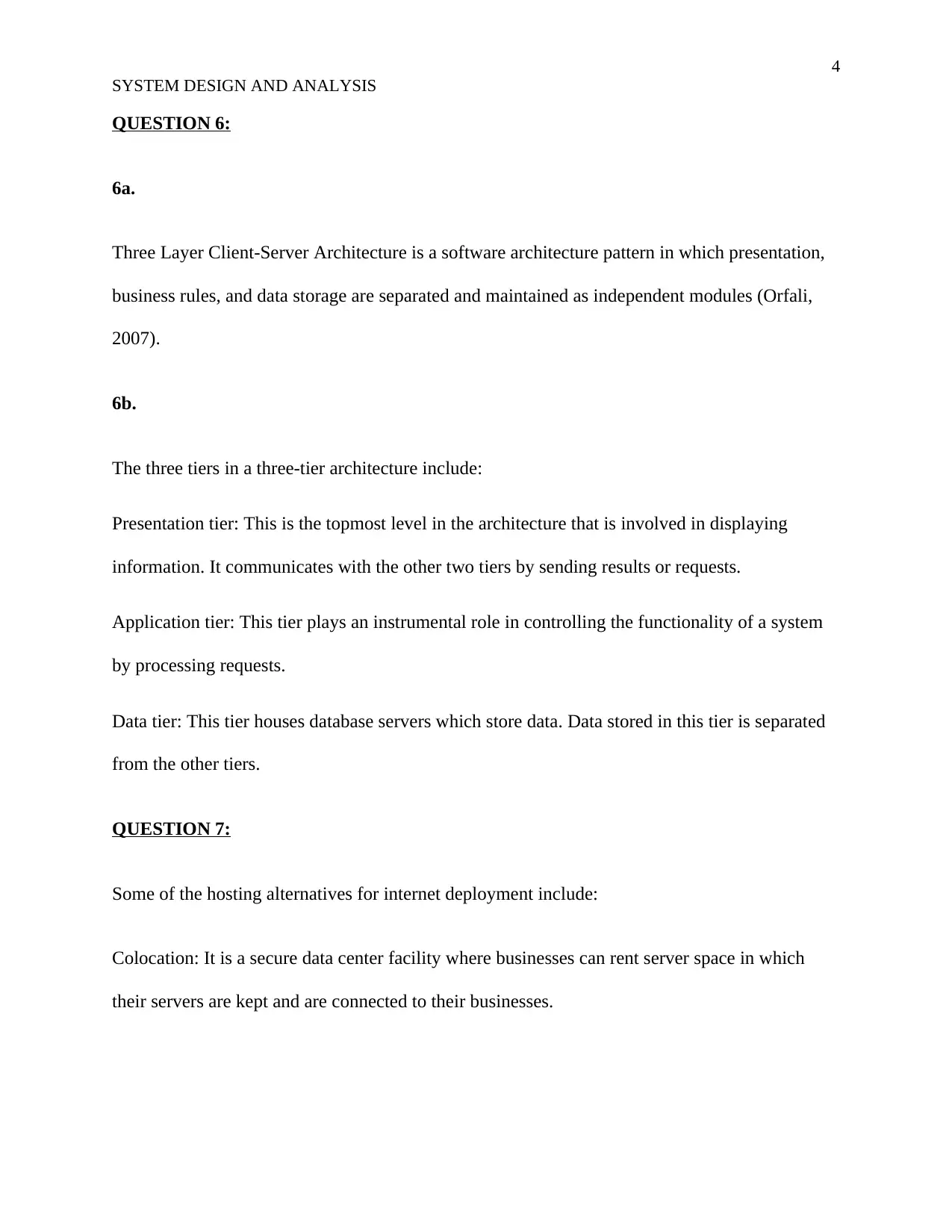
4
SYSTEM DESIGN AND ANALYSIS
QUESTION 6:
6a.
Three Layer Client-Server Architecture is a software architecture pattern in which presentation,
business rules, and data storage are separated and maintained as independent modules (Orfali,
2007).
6b.
The three tiers in a three-tier architecture include:
Presentation tier: This is the topmost level in the architecture that is involved in displaying
information. It communicates with the other two tiers by sending results or requests.
Application tier: This tier plays an instrumental role in controlling the functionality of a system
by processing requests.
Data tier: This tier houses database servers which store data. Data stored in this tier is separated
from the other tiers.
QUESTION 7:
Some of the hosting alternatives for internet deployment include:
Colocation: It is a secure data center facility where businesses can rent server space in which
their servers are kept and are connected to their businesses.
SYSTEM DESIGN AND ANALYSIS
QUESTION 6:
6a.
Three Layer Client-Server Architecture is a software architecture pattern in which presentation,
business rules, and data storage are separated and maintained as independent modules (Orfali,
2007).
6b.
The three tiers in a three-tier architecture include:
Presentation tier: This is the topmost level in the architecture that is involved in displaying
information. It communicates with the other two tiers by sending results or requests.
Application tier: This tier plays an instrumental role in controlling the functionality of a system
by processing requests.
Data tier: This tier houses database servers which store data. Data stored in this tier is separated
from the other tiers.
QUESTION 7:
Some of the hosting alternatives for internet deployment include:
Colocation: It is a secure data center facility where businesses can rent server space in which
their servers are kept and are connected to their businesses.
Paraphrase This Document
Need a fresh take? Get an instant paraphrase of this document with our AI Paraphraser
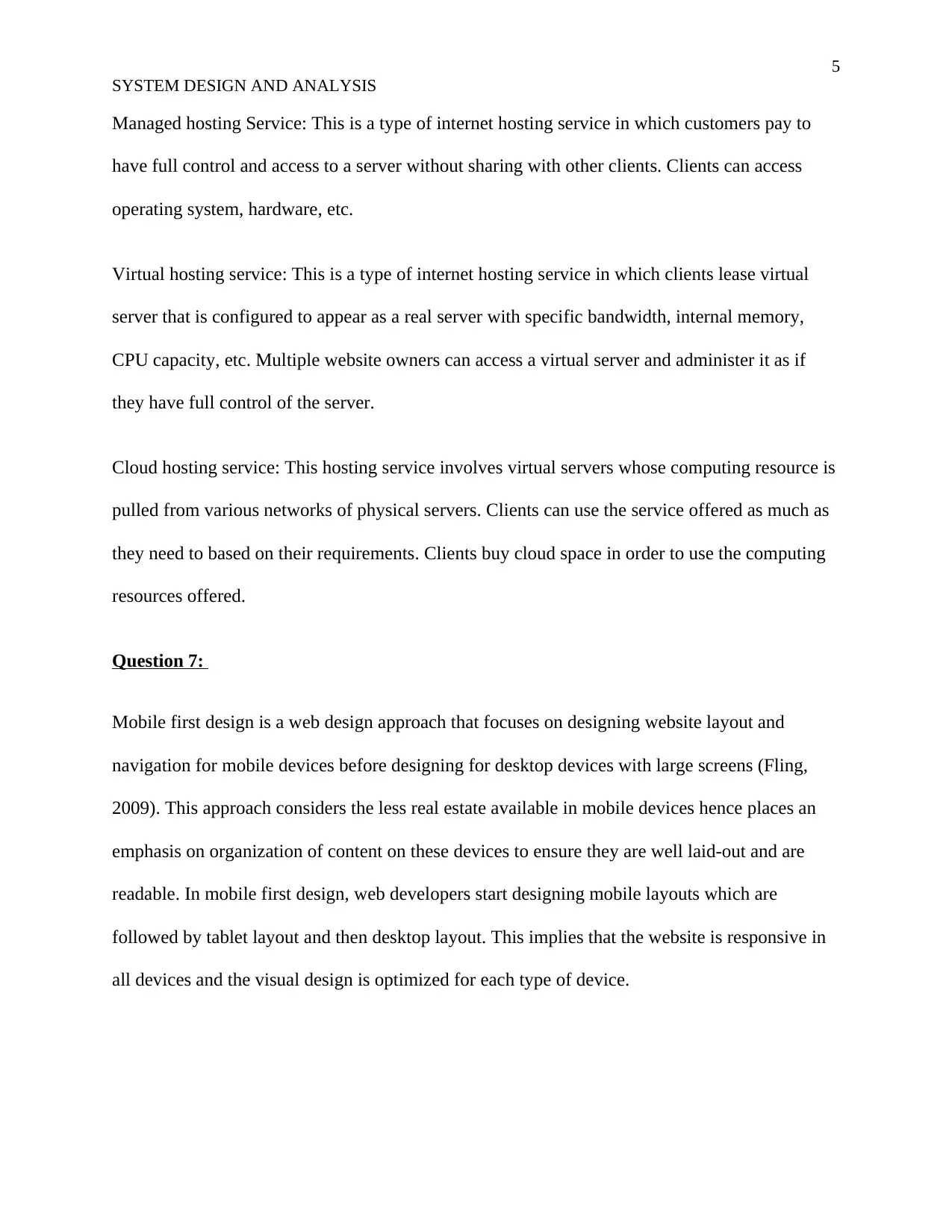
5
SYSTEM DESIGN AND ANALYSIS
Managed hosting Service: This is a type of internet hosting service in which customers pay to
have full control and access to a server without sharing with other clients. Clients can access
operating system, hardware, etc.
Virtual hosting service: This is a type of internet hosting service in which clients lease virtual
server that is configured to appear as a real server with specific bandwidth, internal memory,
CPU capacity, etc. Multiple website owners can access a virtual server and administer it as if
they have full control of the server.
Cloud hosting service: This hosting service involves virtual servers whose computing resource is
pulled from various networks of physical servers. Clients can use the service offered as much as
they need to based on their requirements. Clients buy cloud space in order to use the computing
resources offered.
Question 7:
Mobile first design is a web design approach that focuses on designing website layout and
navigation for mobile devices before designing for desktop devices with large screens (Fling,
2009). This approach considers the less real estate available in mobile devices hence places an
emphasis on organization of content on these devices to ensure they are well laid-out and are
readable. In mobile first design, web developers start designing mobile layouts which are
followed by tablet layout and then desktop layout. This implies that the website is responsive in
all devices and the visual design is optimized for each type of device.
SYSTEM DESIGN AND ANALYSIS
Managed hosting Service: This is a type of internet hosting service in which customers pay to
have full control and access to a server without sharing with other clients. Clients can access
operating system, hardware, etc.
Virtual hosting service: This is a type of internet hosting service in which clients lease virtual
server that is configured to appear as a real server with specific bandwidth, internal memory,
CPU capacity, etc. Multiple website owners can access a virtual server and administer it as if
they have full control of the server.
Cloud hosting service: This hosting service involves virtual servers whose computing resource is
pulled from various networks of physical servers. Clients can use the service offered as much as
they need to based on their requirements. Clients buy cloud space in order to use the computing
resources offered.
Question 7:
Mobile first design is a web design approach that focuses on designing website layout and
navigation for mobile devices before designing for desktop devices with large screens (Fling,
2009). This approach considers the less real estate available in mobile devices hence places an
emphasis on organization of content on these devices to ensure they are well laid-out and are
readable. In mobile first design, web developers start designing mobile layouts which are
followed by tablet layout and then desktop layout. This implies that the website is responsive in
all devices and the visual design is optimized for each type of device.
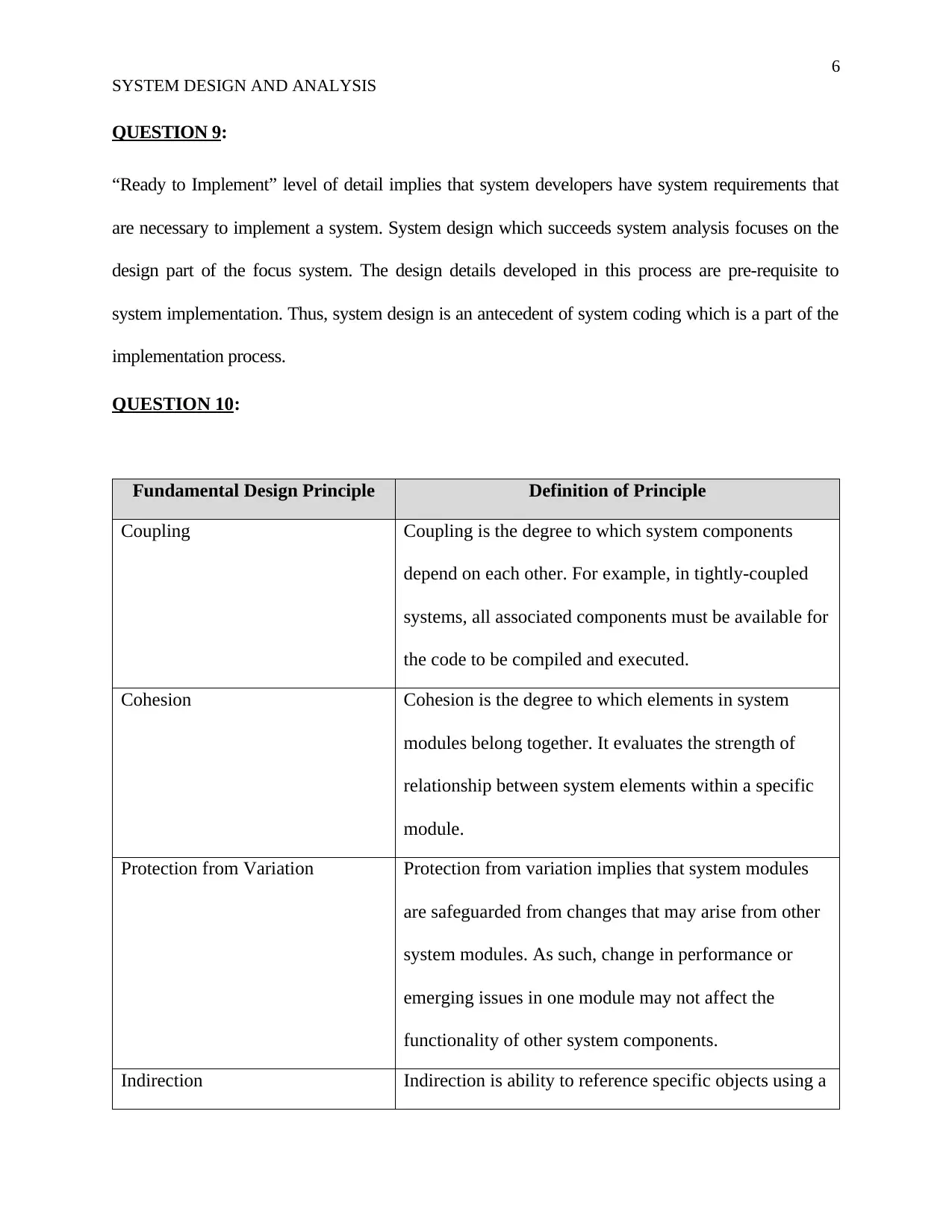
6
SYSTEM DESIGN AND ANALYSIS
QUESTION 9:
“Ready to Implement” level of detail implies that system developers have system requirements that
are necessary to implement a system. System design which succeeds system analysis focuses on the
design part of the focus system. The design details developed in this process are pre-requisite to
system implementation. Thus, system design is an antecedent of system coding which is a part of the
implementation process.
QUESTION 10:
Fundamental Design Principle Definition of Principle
Coupling Coupling is the degree to which system components
depend on each other. For example, in tightly-coupled
systems, all associated components must be available for
the code to be compiled and executed.
Cohesion Cohesion is the degree to which elements in system
modules belong together. It evaluates the strength of
relationship between system elements within a specific
module.
Protection from Variation Protection from variation implies that system modules
are safeguarded from changes that may arise from other
system modules. As such, change in performance or
emerging issues in one module may not affect the
functionality of other system components.
Indirection Indirection is ability to reference specific objects using a
SYSTEM DESIGN AND ANALYSIS
QUESTION 9:
“Ready to Implement” level of detail implies that system developers have system requirements that
are necessary to implement a system. System design which succeeds system analysis focuses on the
design part of the focus system. The design details developed in this process are pre-requisite to
system implementation. Thus, system design is an antecedent of system coding which is a part of the
implementation process.
QUESTION 10:
Fundamental Design Principle Definition of Principle
Coupling Coupling is the degree to which system components
depend on each other. For example, in tightly-coupled
systems, all associated components must be available for
the code to be compiled and executed.
Cohesion Cohesion is the degree to which elements in system
modules belong together. It evaluates the strength of
relationship between system elements within a specific
module.
Protection from Variation Protection from variation implies that system modules
are safeguarded from changes that may arise from other
system modules. As such, change in performance or
emerging issues in one module may not affect the
functionality of other system components.
Indirection Indirection is ability to reference specific objects using a
⊘ This is a preview!⊘
Do you want full access?
Subscribe today to unlock all pages.

Trusted by 1+ million students worldwide
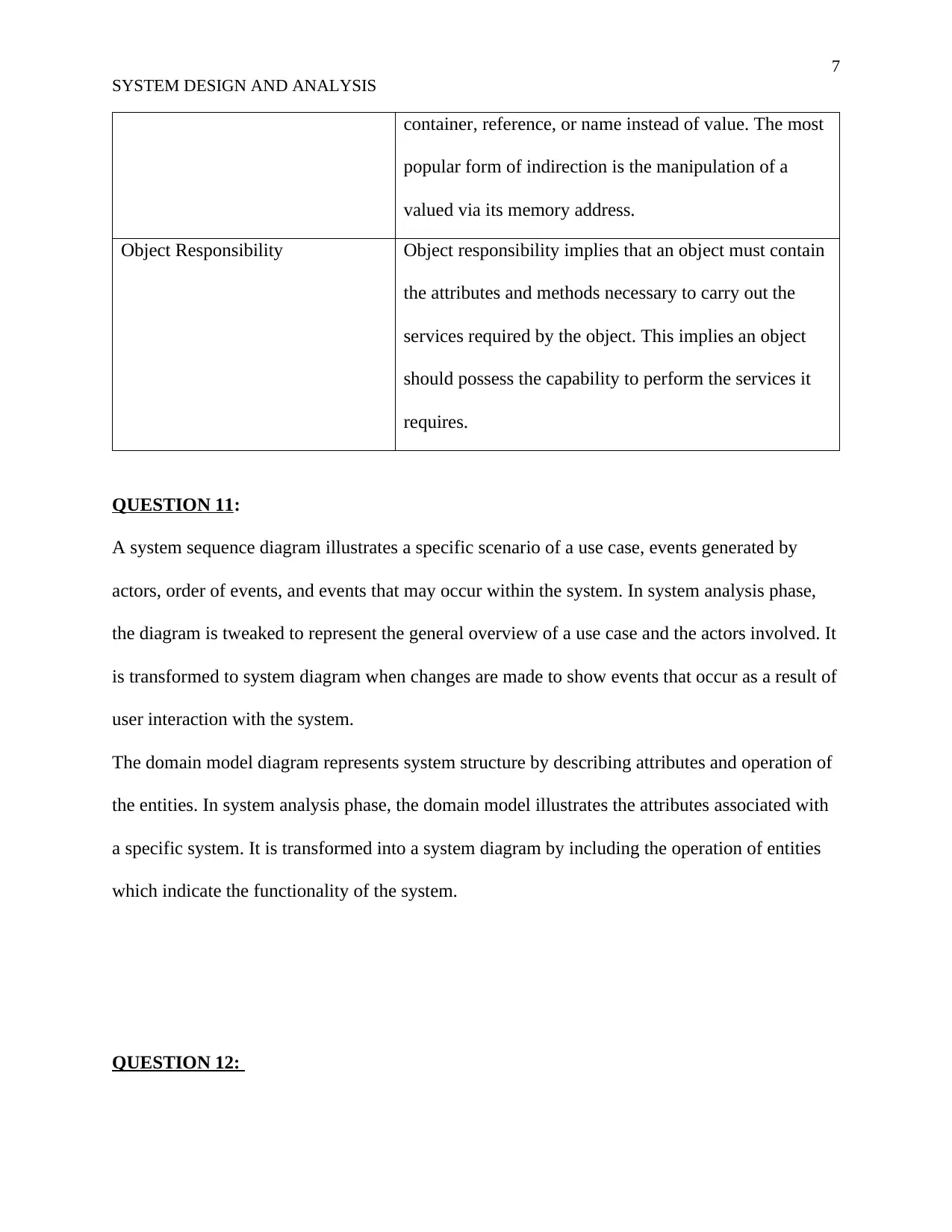
7
SYSTEM DESIGN AND ANALYSIS
container, reference, or name instead of value. The most
popular form of indirection is the manipulation of a
valued via its memory address.
Object Responsibility Object responsibility implies that an object must contain
the attributes and methods necessary to carry out the
services required by the object. This implies an object
should possess the capability to perform the services it
requires.
QUESTION 11:
A system sequence diagram illustrates a specific scenario of a use case, events generated by
actors, order of events, and events that may occur within the system. In system analysis phase,
the diagram is tweaked to represent the general overview of a use case and the actors involved. It
is transformed to system diagram when changes are made to show events that occur as a result of
user interaction with the system.
The domain model diagram represents system structure by describing attributes and operation of
the entities. In system analysis phase, the domain model illustrates the attributes associated with
a specific system. It is transformed into a system diagram by including the operation of entities
which indicate the functionality of the system.
QUESTION 12:
SYSTEM DESIGN AND ANALYSIS
container, reference, or name instead of value. The most
popular form of indirection is the manipulation of a
valued via its memory address.
Object Responsibility Object responsibility implies that an object must contain
the attributes and methods necessary to carry out the
services required by the object. This implies an object
should possess the capability to perform the services it
requires.
QUESTION 11:
A system sequence diagram illustrates a specific scenario of a use case, events generated by
actors, order of events, and events that may occur within the system. In system analysis phase,
the diagram is tweaked to represent the general overview of a use case and the actors involved. It
is transformed to system diagram when changes are made to show events that occur as a result of
user interaction with the system.
The domain model diagram represents system structure by describing attributes and operation of
the entities. In system analysis phase, the domain model illustrates the attributes associated with
a specific system. It is transformed into a system diagram by including the operation of entities
which indicate the functionality of the system.
QUESTION 12:
Paraphrase This Document
Need a fresh take? Get an instant paraphrase of this document with our AI Paraphraser
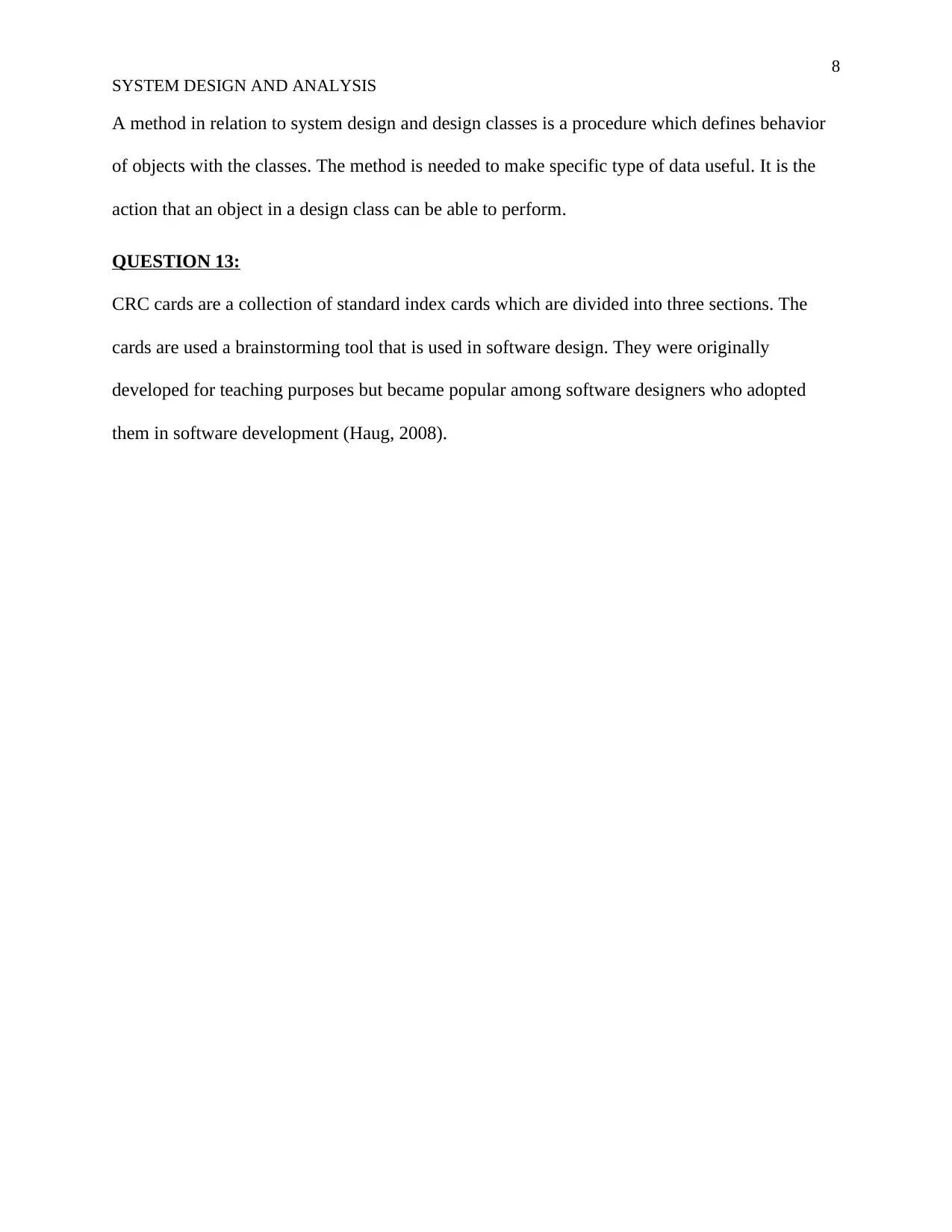
8
SYSTEM DESIGN AND ANALYSIS
A method in relation to system design and design classes is a procedure which defines behavior
of objects with the classes. The method is needed to make specific type of data useful. It is the
action that an object in a design class can be able to perform.
QUESTION 13:
CRC cards are a collection of standard index cards which are divided into three sections. The
cards are used a brainstorming tool that is used in software design. They were originally
developed for teaching purposes but became popular among software designers who adopted
them in software development (Haug, 2008).
SYSTEM DESIGN AND ANALYSIS
A method in relation to system design and design classes is a procedure which defines behavior
of objects with the classes. The method is needed to make specific type of data useful. It is the
action that an object in a design class can be able to perform.
QUESTION 13:
CRC cards are a collection of standard index cards which are divided into three sections. The
cards are used a brainstorming tool that is used in software design. They were originally
developed for teaching purposes but became popular among software designers who adopted
them in software development (Haug, 2008).
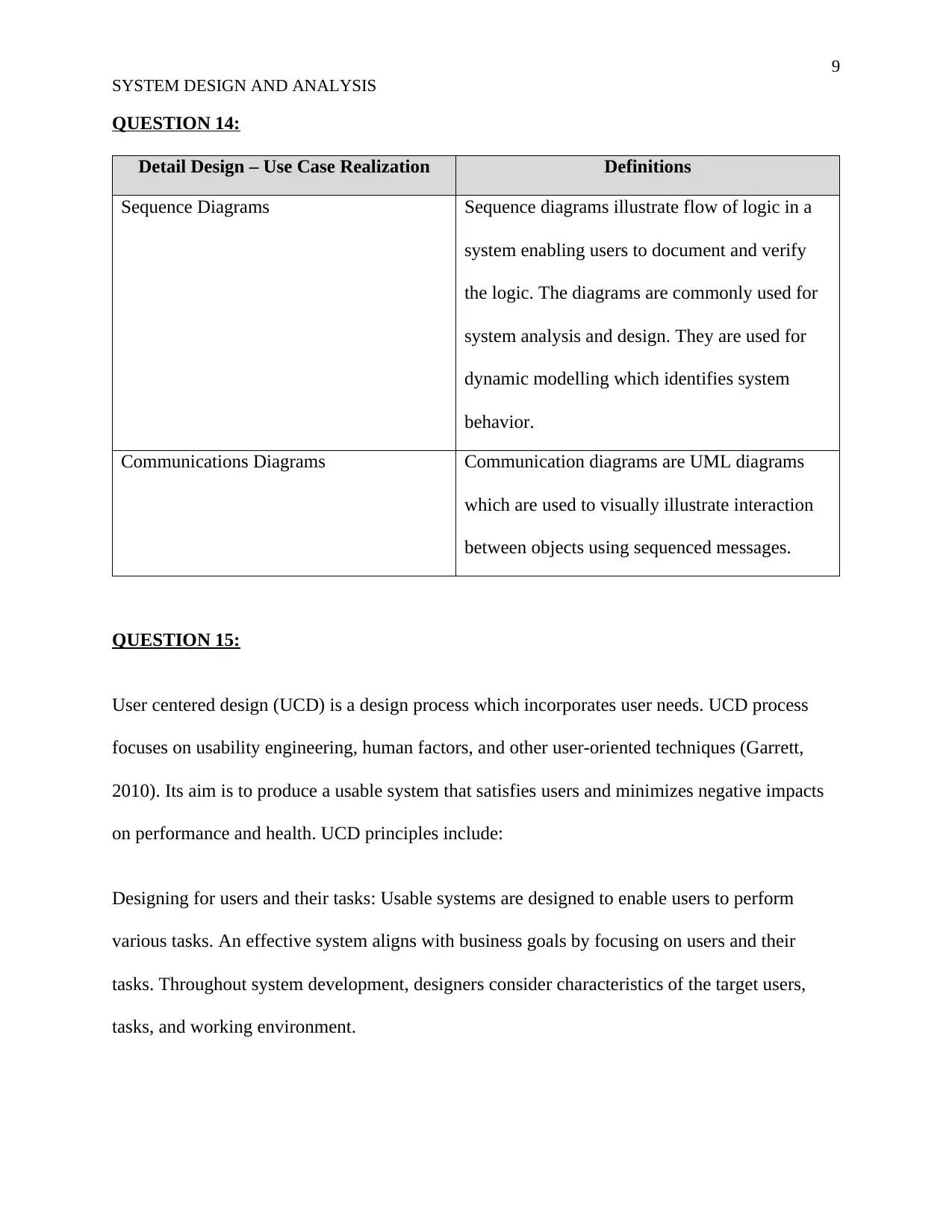
9
SYSTEM DESIGN AND ANALYSIS
QUESTION 14:
Detail Design – Use Case Realization Definitions
Sequence Diagrams Sequence diagrams illustrate flow of logic in a
system enabling users to document and verify
the logic. The diagrams are commonly used for
system analysis and design. They are used for
dynamic modelling which identifies system
behavior.
Communications Diagrams Communication diagrams are UML diagrams
which are used to visually illustrate interaction
between objects using sequenced messages.
QUESTION 15:
User centered design (UCD) is a design process which incorporates user needs. UCD process
focuses on usability engineering, human factors, and other user-oriented techniques (Garrett,
2010). Its aim is to produce a usable system that satisfies users and minimizes negative impacts
on performance and health. UCD principles include:
Designing for users and their tasks: Usable systems are designed to enable users to perform
various tasks. An effective system aligns with business goals by focusing on users and their
tasks. Throughout system development, designers consider characteristics of the target users,
tasks, and working environment.
SYSTEM DESIGN AND ANALYSIS
QUESTION 14:
Detail Design – Use Case Realization Definitions
Sequence Diagrams Sequence diagrams illustrate flow of logic in a
system enabling users to document and verify
the logic. The diagrams are commonly used for
system analysis and design. They are used for
dynamic modelling which identifies system
behavior.
Communications Diagrams Communication diagrams are UML diagrams
which are used to visually illustrate interaction
between objects using sequenced messages.
QUESTION 15:
User centered design (UCD) is a design process which incorporates user needs. UCD process
focuses on usability engineering, human factors, and other user-oriented techniques (Garrett,
2010). Its aim is to produce a usable system that satisfies users and minimizes negative impacts
on performance and health. UCD principles include:
Designing for users and their tasks: Usable systems are designed to enable users to perform
various tasks. An effective system aligns with business goals by focusing on users and their
tasks. Throughout system development, designers consider characteristics of the target users,
tasks, and working environment.
⊘ This is a preview!⊘
Do you want full access?
Subscribe today to unlock all pages.

Trusted by 1+ million students worldwide
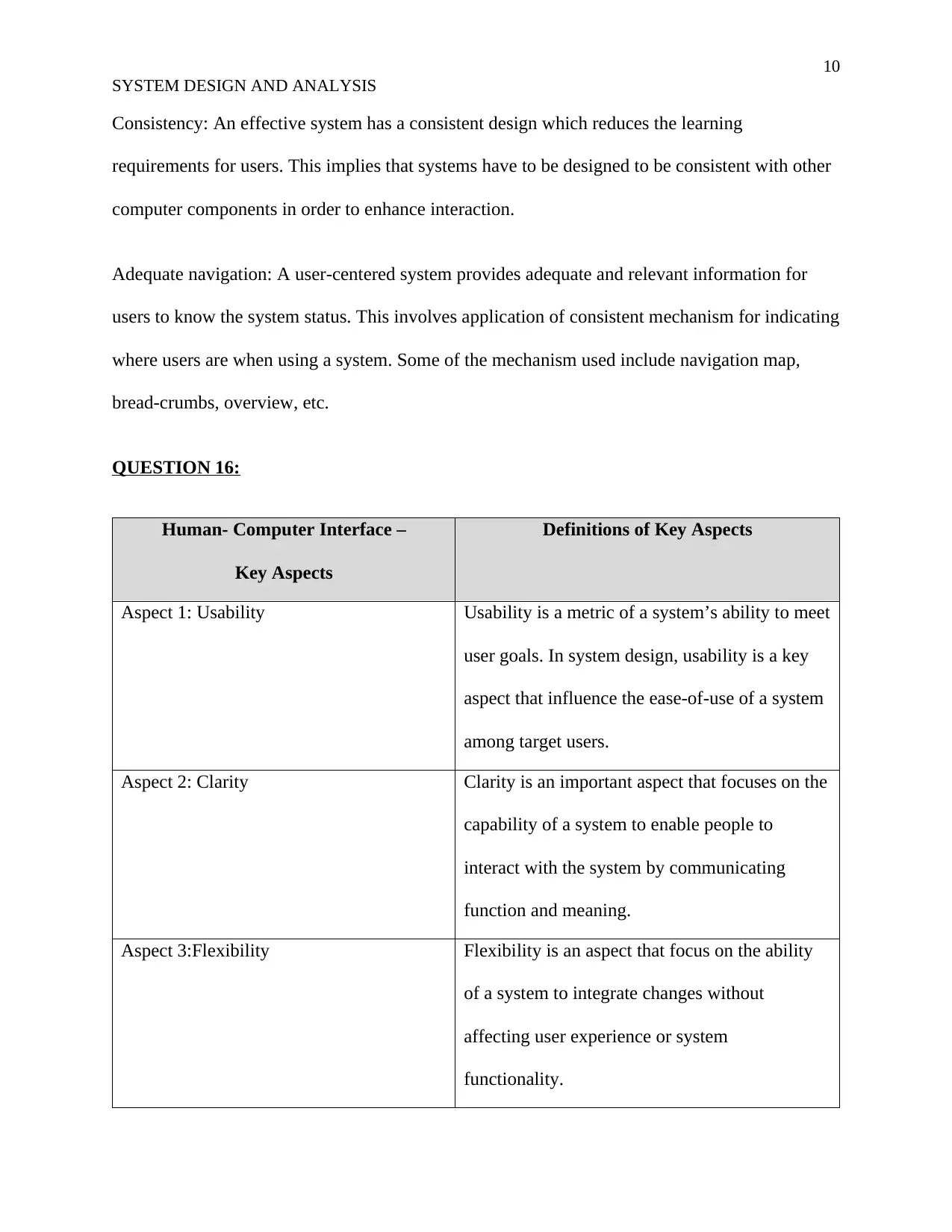
10
SYSTEM DESIGN AND ANALYSIS
Consistency: An effective system has a consistent design which reduces the learning
requirements for users. This implies that systems have to be designed to be consistent with other
computer components in order to enhance interaction.
Adequate navigation: A user-centered system provides adequate and relevant information for
users to know the system status. This involves application of consistent mechanism for indicating
where users are when using a system. Some of the mechanism used include navigation map,
bread-crumbs, overview, etc.
QUESTION 16:
Human- Computer Interface –
Key Aspects
Definitions of Key Aspects
Aspect 1: Usability Usability is a metric of a system’s ability to meet
user goals. In system design, usability is a key
aspect that influence the ease-of-use of a system
among target users.
Aspect 2: Clarity Clarity is an important aspect that focuses on the
capability of a system to enable people to
interact with the system by communicating
function and meaning.
Aspect 3:Flexibility Flexibility is an aspect that focus on the ability
of a system to integrate changes without
affecting user experience or system
functionality.
SYSTEM DESIGN AND ANALYSIS
Consistency: An effective system has a consistent design which reduces the learning
requirements for users. This implies that systems have to be designed to be consistent with other
computer components in order to enhance interaction.
Adequate navigation: A user-centered system provides adequate and relevant information for
users to know the system status. This involves application of consistent mechanism for indicating
where users are when using a system. Some of the mechanism used include navigation map,
bread-crumbs, overview, etc.
QUESTION 16:
Human- Computer Interface –
Key Aspects
Definitions of Key Aspects
Aspect 1: Usability Usability is a metric of a system’s ability to meet
user goals. In system design, usability is a key
aspect that influence the ease-of-use of a system
among target users.
Aspect 2: Clarity Clarity is an important aspect that focuses on the
capability of a system to enable people to
interact with the system by communicating
function and meaning.
Aspect 3:Flexibility Flexibility is an aspect that focus on the ability
of a system to integrate changes without
affecting user experience or system
functionality.
Paraphrase This Document
Need a fresh take? Get an instant paraphrase of this document with our AI Paraphraser
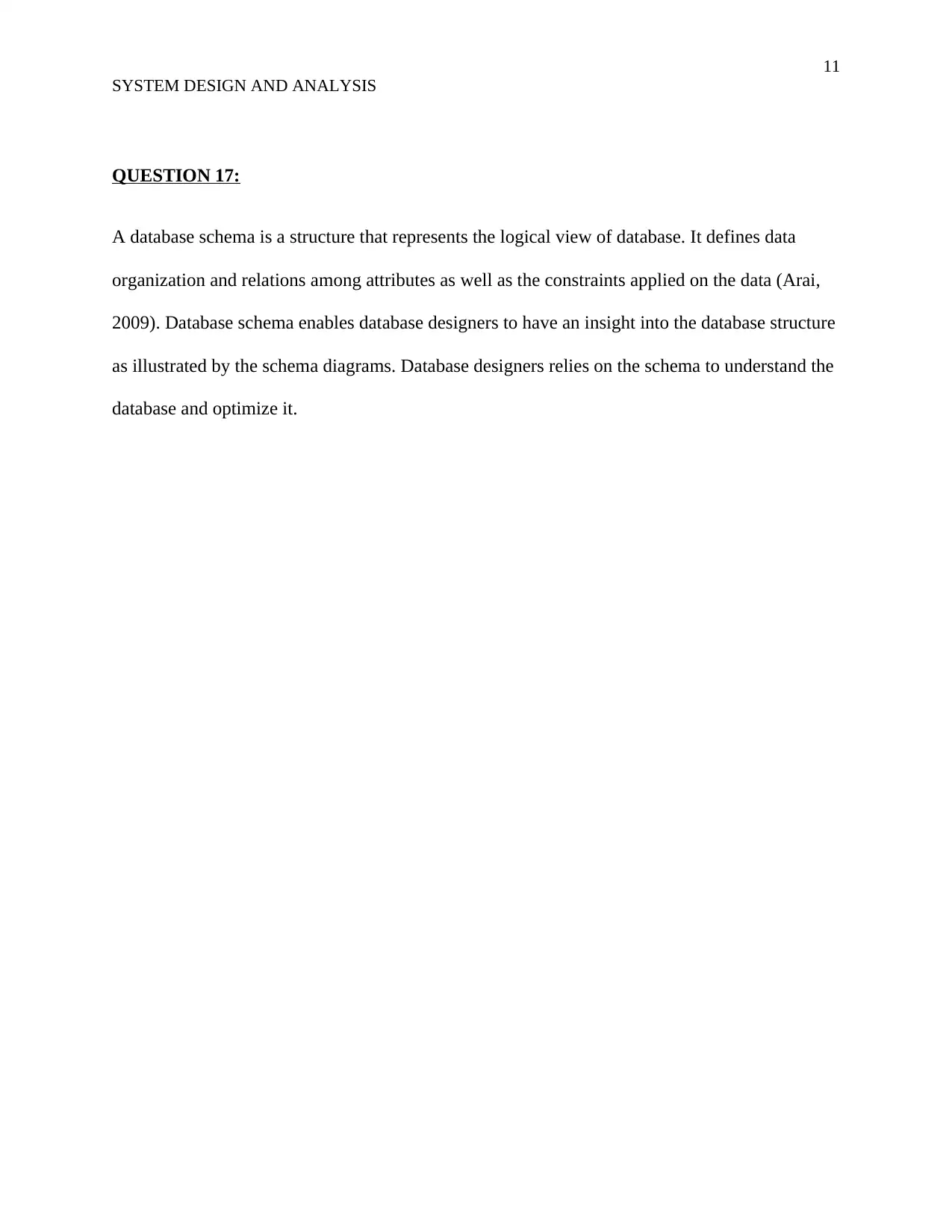
11
SYSTEM DESIGN AND ANALYSIS
QUESTION 17:
A database schema is a structure that represents the logical view of database. It defines data
organization and relations among attributes as well as the constraints applied on the data (Arai,
2009). Database schema enables database designers to have an insight into the database structure
as illustrated by the schema diagrams. Database designers relies on the schema to understand the
database and optimize it.
SYSTEM DESIGN AND ANALYSIS
QUESTION 17:
A database schema is a structure that represents the logical view of database. It defines data
organization and relations among attributes as well as the constraints applied on the data (Arai,
2009). Database schema enables database designers to have an insight into the database structure
as illustrated by the schema diagrams. Database designers relies on the schema to understand the
database and optimize it.
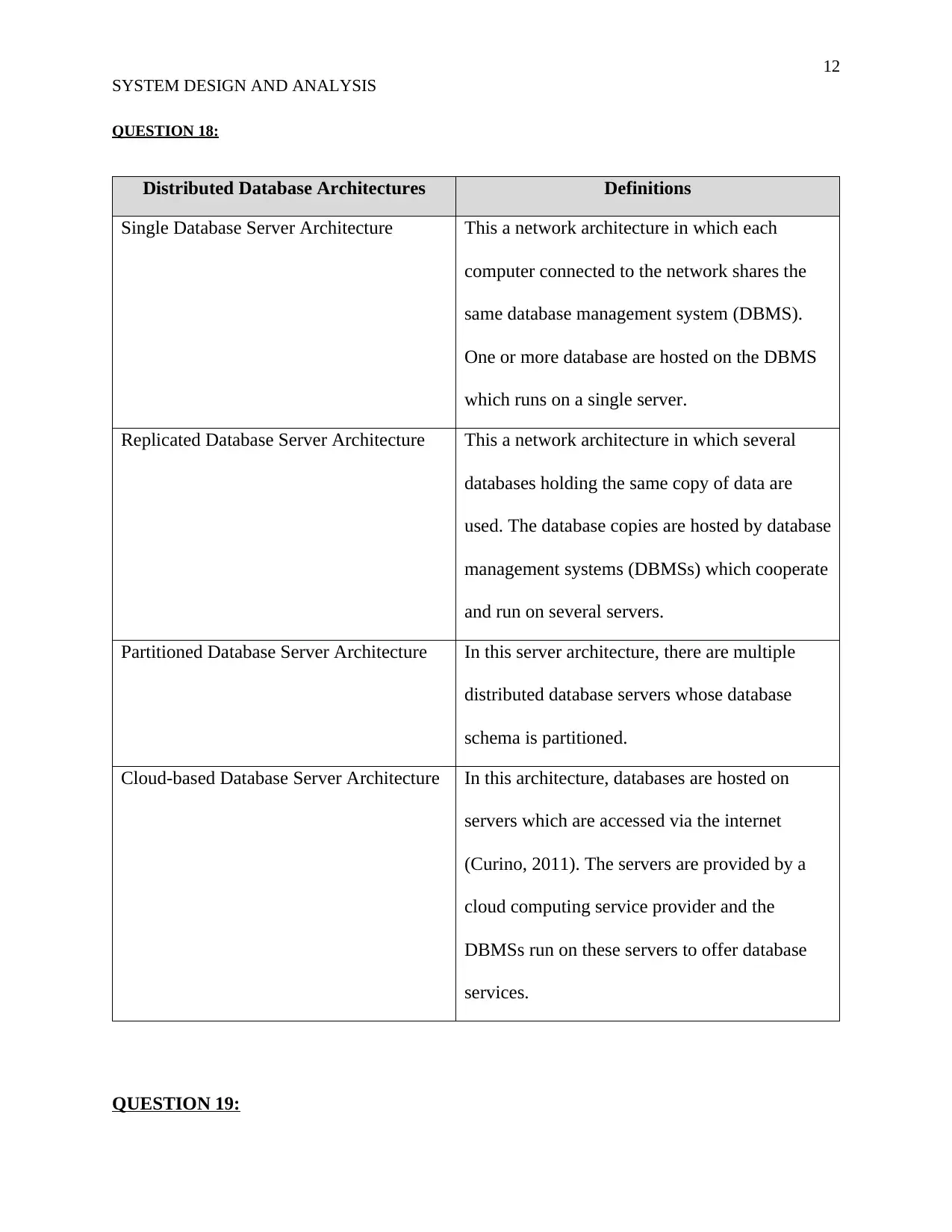
12
SYSTEM DESIGN AND ANALYSIS
QUESTION 18:
Distributed Database Architectures Definitions
Single Database Server Architecture This a network architecture in which each
computer connected to the network shares the
same database management system (DBMS).
One or more database are hosted on the DBMS
which runs on a single server.
Replicated Database Server Architecture This a network architecture in which several
databases holding the same copy of data are
used. The database copies are hosted by database
management systems (DBMSs) which cooperate
and run on several servers.
Partitioned Database Server Architecture In this server architecture, there are multiple
distributed database servers whose database
schema is partitioned.
Cloud-based Database Server Architecture In this architecture, databases are hosted on
servers which are accessed via the internet
(Curino, 2011). The servers are provided by a
cloud computing service provider and the
DBMSs run on these servers to offer database
services.
QUESTION 19:
SYSTEM DESIGN AND ANALYSIS
QUESTION 18:
Distributed Database Architectures Definitions
Single Database Server Architecture This a network architecture in which each
computer connected to the network shares the
same database management system (DBMS).
One or more database are hosted on the DBMS
which runs on a single server.
Replicated Database Server Architecture This a network architecture in which several
databases holding the same copy of data are
used. The database copies are hosted by database
management systems (DBMSs) which cooperate
and run on several servers.
Partitioned Database Server Architecture In this server architecture, there are multiple
distributed database servers whose database
schema is partitioned.
Cloud-based Database Server Architecture In this architecture, databases are hosted on
servers which are accessed via the internet
(Curino, 2011). The servers are provided by a
cloud computing service provider and the
DBMSs run on these servers to offer database
services.
QUESTION 19:
⊘ This is a preview!⊘
Do you want full access?
Subscribe today to unlock all pages.

Trusted by 1+ million students worldwide
1 out of 14
Related Documents
Your All-in-One AI-Powered Toolkit for Academic Success.
+13062052269
info@desklib.com
Available 24*7 on WhatsApp / Email
![[object Object]](/_next/static/media/star-bottom.7253800d.svg)
Unlock your academic potential
Copyright © 2020–2025 A2Z Services. All Rights Reserved. Developed and managed by ZUCOL.





